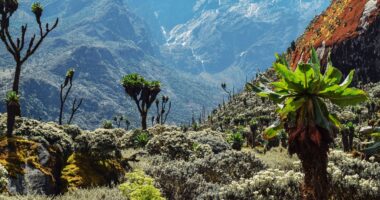
The capsule from Japan’s Hayabusa 2 mission revealed a large amount of asteroid material.
Photo: handout/Agence France-Presse/Getty Images
TOKYO—Japan’s space agency said it recovered far more black dirt than it was targeting from the asteroid Ryugu, confirming the success of its Hayabusa 2 mission nine days after it delivered its payload to the Australian outback.
Scientists plan to study the material, which is thought to retain the chemical composition of the early solar system some 4.6 billion years ago, for clues to the origins of life on earth.
The Hayabusa 2 mission was launched in 2014. It collected samples from the surface of Ryugu and from an artificial crater on the asteroid created by firing a projectile.
“ ‘It was so far beyond our predictions that we were practically at a loss for words.’ ”
After traveling more than 3.2 billion miles, Hayabusa 2 flew by earth early this month and dropped a capsule with the samples inside. The capsule created a fiery trail as it plummeted through the atmosphere and, after extending a parachute, it landed in Australia on Dec. 6.
The Japan Aerospace Exploration Agency, or JAXA, had said it hoped to collect at least 0.1 gram of material, the equivalent of a few grains of rice. But it couldn’t be sure at first whether anything was inside the capsule and whether there was leakage during the descent.
On Tuesday, after flying the capsule back to Japan, JAXA scientists opened the chamber expected to contain Ryugu surface samples. A surprise awaited them.

The sample was successfully recovered after being dropped to Earth by the Hayabusa 2 probe.
Photo: handout/Agence France-Presse/Getty Images
“It was so far beyond our predictions that we were practically at a loss for words. It was really emotional,” said JAXA scientist Hirotaka Sawada, who was present at the opening. “It wasn’t just tiny powdery particles. There were crumbly samples in there with a size of several millimeters.”
He added, “We were able to obtain an amount far exceeding our expectations,” although he declined to estimate the weight of the material.
JAXA scientists said the capsule stayed well-sealed throughout, and the crumbly dirt was confirmed to come from carbon-rich Ryugu, as its black hue suggested. They said they also secured gases emitted by the asteroid material, in what they described as the first sample of extraterrestrial gases collected by humans.
One theory about the origin of life on earth holds that amino acids, life’s building blocks, were brought to earth by asteroids or meteorites. The samples of dirt and gas from Ryugu might help prove that theory.

The capsule landed in Australia with help from a parachute.
Photo: handout/Agence France-Presse/Getty Images
Write to Peter Landers at [email protected]
Copyright ©2020 Dow Jones & Company, Inc. All Rights Reserved. 87990cbe856818d5eddac44c7b1cdeb8









